
It’s funny, when I meet people who are leveraging content marketing, they always tell me one of two things…
Either they can’t figure out how to generate traffic (no matter how many blog posts they publish)…
OR
They’ve figured out how to generate more traffic, but the traffic hasn’t turned into any sales or new customers and they can’t figure out why.
Now, I know what you are thinking… there are so many companies that make millions from content marketing that there must be a way to make it work.
But here’s the thing. Because of my ad agency, I am able to talk to thousands of companies each year and dig into their marketing. And of the ones that leverage content marketing, most aren’t able to generate even one sale from it.
In other words, it’s not working for them.
It’s not because content marketing is flawed. It’s that most people don’t fully understand it.
Why doesn’t content marketing work for most businesses?
What most people don’t realize is that all visitors are not the same. And I’m not talking about demographics and income, I’m talking about intent.
When you land on a web page that ranks on Google because of content marketing, your actions are going to be different than if you clicked on a paid listing.
And it’s not because one is paid and one is organic… here’s what I mean.
When you do a search on Google for the term “auto insurance” you’ll see a search results page that looks something like this:
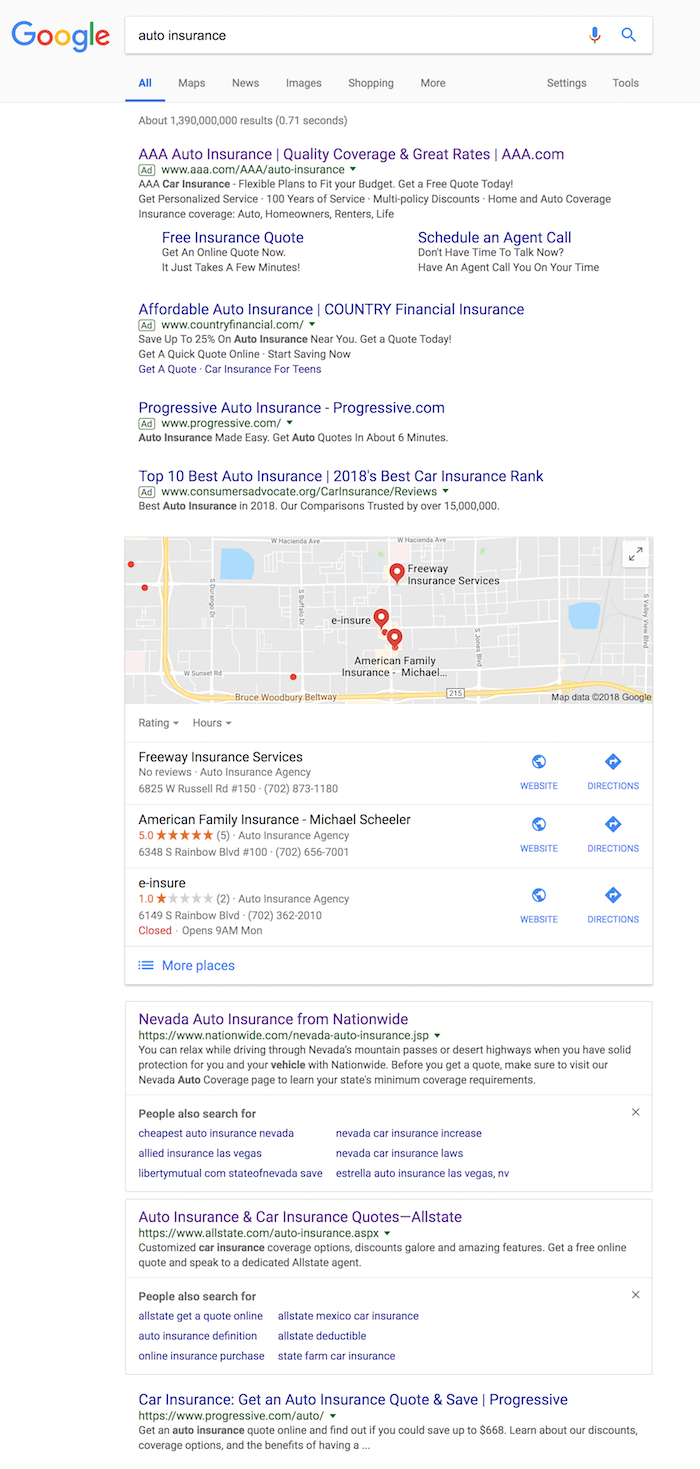
And you’ll either click on a paid listing or an organic one.
Here’s what one of the paid listings looks like:

And here’s what one of the organic listings looks like:

As you can see, the organic listing contains a lot of content… including information about the city where I performed the search, insurance options, and why I should choose Nationwide.
To some extent, it is educational and salesy all at the same time, but I’m not being sold as hard as the paid listing from AAA.
The AAA landing page only has 73 keywords. That’s it… a measly 73 keywords.
In other words, if you land on the AAA landing page you are going to click on one of the two insurance options.
On the other hand, if you land on the Nationwide site (who leverages content marketing), your eyes focus on the text instead of filling out the auto insurance lead form.
And that’s what I mean by intent.
Even though I performed the search “auto insurance,” I’m more likely to buy from the AAA site because it’s a more aggressive landing page. The Nationwide site puts me in a more educational mindset, in which I am going to read and do some research versus just getting a quote.
And Nationwide isn’t doing this because they want to educate. They are doing this because it is really hard to rank organically without providing tons of content.
Google loves content, hence the average web page that ranks on page one contains 1,890 words.
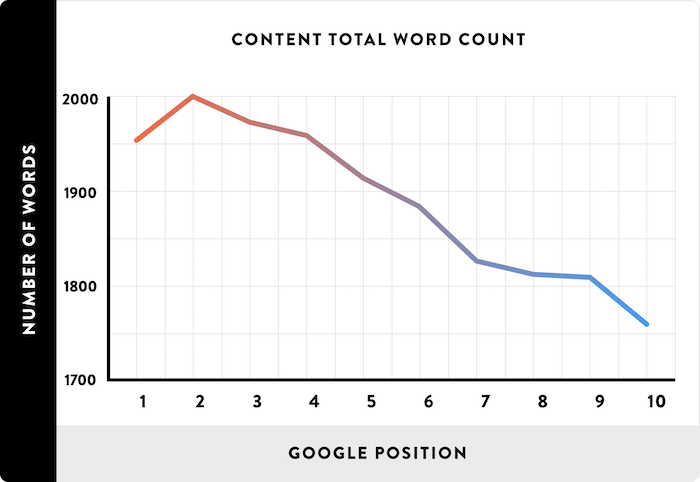
That’s why Wikipedia ranks for everything under the sun.
If you are going to leverage content marketing, you have to keep in mind that when people land on your site it will put them in the mood of reading and learning instead of buying.
So, does that mean content marketing doesn’t work?
Content marketing is amazing, and it still works really well. It doesn’t produce as many conversions as paid advertising, but you can also build up massive amounts of traffic without burning a hole in your wallet.
Let’s look at NeilPatel.com and how I leverage content marketing.
Over the last 31 days, this blog has generated 2,510,893 visits of which 1,609,314 were unique. And those visitors generated 5,890,103 pageviews.
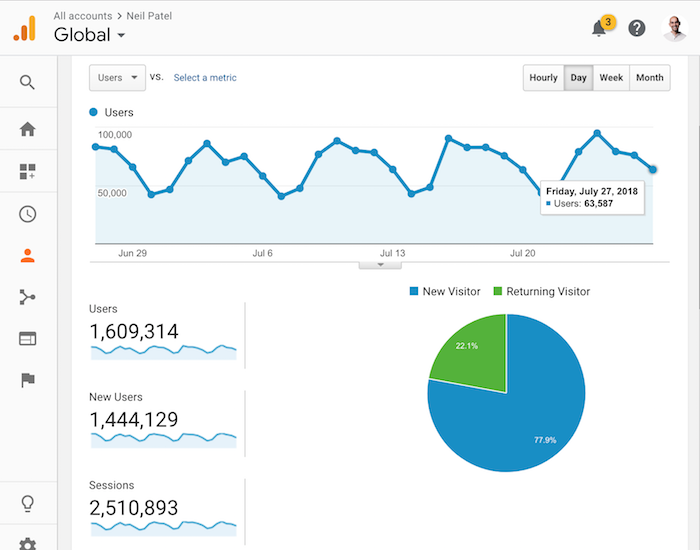
That’s not bad, especially if you consider that I am not really leveraging paid ads (other than the few blog posts I modestly boost on Facebook each month).
And during that time period, we generated 1,942 leads within the United States of which 262 came from companies who were spending over $5,000 a month on marketing.

Most leads don’t turn into sales within 30 days as our sales cycle is longer, but so far those leads have generated $972,860 in contract value (we haven’t collected all of that money yet, but we will over the next 12 months).
The number I shared above is just revenue, it’s not profit. That number, of course, will go up as many more of the leads will turn into contracts but at the same time, my expenses will go up too.
So, can you guess how I generated almost a million dollars in new contracts in just 30 days.
Well first off, it wasn’t me… I have an amazing sales team lead by a guy named Nick Roshan. And we have an amazing fulfillment team that helps the sales team close more deals.
But the lead generation is all me… and that came from content marketing.
In other words, content marketing works… as long as you think about it the right way.
So how should you think about content marketing?
The first part is traffic. You need traffic before you can do anything else.
How do you build up traffic via content marketing?
Well, you need to write blog posts. I won’t go too in-depth on how to write blog posts as I have tons of blog posts already on that.
- How to write a blog post in 45 minutes – this post breaks down how you can write amazing content without it taking up too much of your time.
- How to become a better blogger in 30 days – once you’ve committed to blogging, you naturally want to improve your skills. This post will teach you how to do that over the next 30 days.
- Or hire my agency – if you just want someone to do it for you, you can always reach out to us.
- Or hire and manage writers yourself – you can always use the Problogger Job Board to find writers.
If you are going to take the route of hiring other writers, make sure you tell them the following rules:
- You and I – use the words “you” and “I” to make the blog posts seem like a conversation. For example, “Don’t you hate it when people tell you that some things just aren’t possible? I know I do.” You see how that sounds conversational?
- 3 sections – a blog post should be structured with 3 main sections: Introduction, body, and conclusion. By structuring every one of your posts the same way, your readers will know what to expect and it will make it easier to skim your content. (The majority of your website visitors will skim and not read.)
- Conclusion – the conclusion should be labeled “Conclusion.” The reason you want to do this is that roughly 8% of your readers will scroll down to the bottom of your blog post to read the conclusion. If they like the conclusion they will scroll back up and read the rest. (The 8% stat is from NeilPatel.com. I’m not sure what the percentage will be for your blog but I used Crazy Egg to figure this out.)
- Subheadings – the body should contain subheadings, that way it is easier for people to skim. The subheadings should describe what the section is about and if you can naturally place keywords within it, feel free to do so. Just don’t force it.
- Short paragraphs – try to keep the paragraphs less than 5 or 6 lines. It’s easier on the eyes, especially on mobile.
- Facts and data – use stats and data to back up your talking points. Feel free to reference other sites and link to them. This will validate your content and also brand you as an authority over time.
- Images – use screenshots and photography to help get your point across. Some people are visual learners, so use images when it makes sense. If you are using someone else’s images, look for copyright information and make sure you cite your sources.
- 2,000 to 3,000 words – it varies per industry, but if you are in a competitive industry, consider making your blog posts 2,000 or more words. I showed you earlier in this post how Google prefers ranking content that is at least 1,890 words on page 1. If you are not in a competitive industry, you can write content that is less than 1,000 words. Over time you can go back to the blog posts that are gaining traction and expand them.
- Headlines have to be amazing – 8 out of 10 people will read your headline but only 2 out of 10 will click through and read the rest of your article. Before you hit the publish button, check out these stats from Buzzsumo on writing appealing headlines.
- End with a question – wrap up your conclusion with a question. People are more likely to leave a comment when you ask them a question. Make sure you do this as you want engagement.
Now that you have the writing process down, it’s time to come up with topic ideas. The easiest way to figure out what’s hot is to just type in keywords within your space on Buzzsumo.
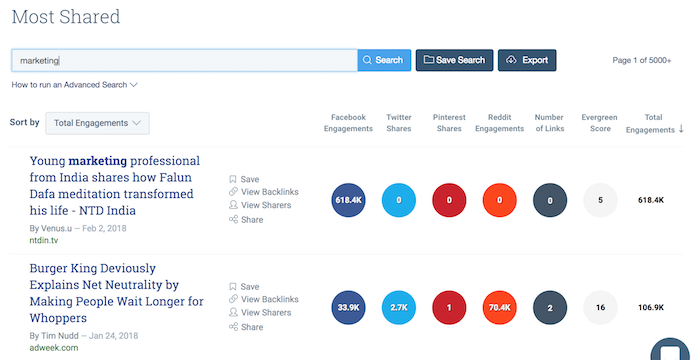
You just insert a keyword and Buzzsumo will show you all of the articles around the web that are popular related to that keyword.
By doing this you will see what people like in your space. I’m not saying you should copy these articles but instead to use them for ideas. The last thing you want to do is write content that people don’t care to read.
In addition to typing in a keyword, you can also type a URL into Buzzsumo. For example, I typed in Hubspot.com and it shows me all of their top articles.
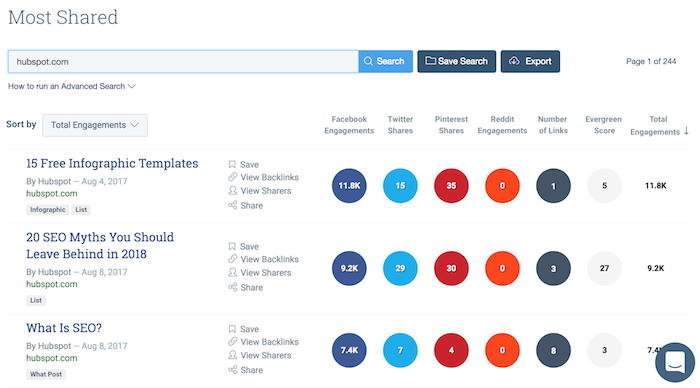
This will give you an idea of what is working for your competition.
Now that you have some topic ideas, it’s time for you to write a blog post (or pay someone to write it for you). Just keep in mind your content has to be better than your competition. If it isn’t better than what they have, it will be hard for you to get more social shares or outrank them.
When I publish a blog post, I like asking myself the following questions:
- Is your blog post more actionable than your competitors? (If not, fix it.)
- Did you write on something unique or provide a different perspective than your competition? (If not, fix it.)
- Would you be embarrassed if a friend or co-worker read your article? (Don’t ever publish something you wouldn’t want others to read… fix your content.)
- Would you be willing to ask other people to share your content on social media and link to it? (If not, make your content better.)
- Did you come up with 10 headline variations? (Don’t settle on your first headline, try to think of better ones.)
Assuming you passed all of the questions, it’s time to publish your content and generate some traffic.
So how do I generate traffic?
Sadly, there is no quick way to grow your traffic. It’s a slow grind, but over time your traffic will go up.
Here’s the traffic to the NeilPatel.com blog when I first started:
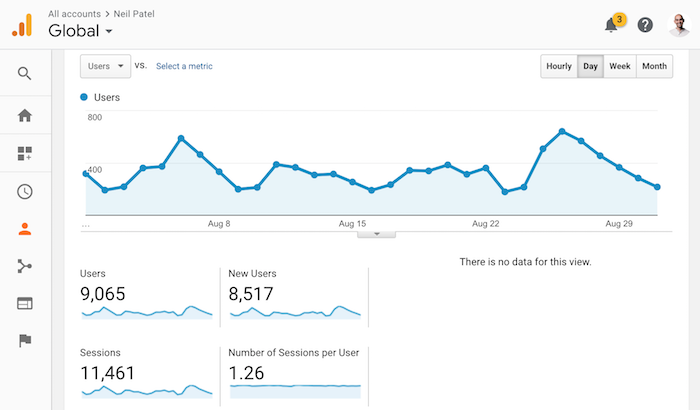
As you can see I generated 9,065 unique visitors in my first month back in August of 2014. I generated those visitors from the 4 strategies that I will break down in a bit (they still work).
And if you fast forward to the 1-year mark, I was able to 10x my traffic by August of 2015.
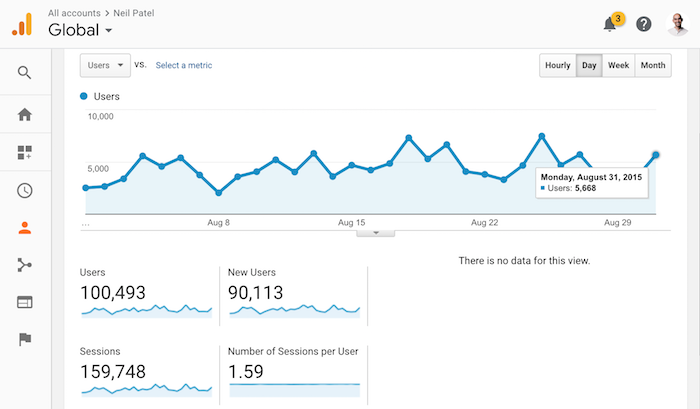
My traffic has continually gone up over time as well, which you can see by scrolling back up towards the beginning of this post (I’m now at 2,510,893 monthly visits, yay!).
So how do you generate more traffic?
Well, first off you need to be patient. Don’t expect the same results I achieved. Marketing is what I do, and I’m willing to dedicate more time and energy than most people.
So here are the 4 strategies I used when I started NeilPatel.com (and I still use them today).
Keep in mind that these tactics work for all types of sites and I’m assuming here that you don’t have a social following, so I won’t be giving you basic advice like “share your article on LinkedIn”.
Strategy #1: Boosting posts
Still to do this day I boost my posts on Facebook. It worked even better when I was starting off, but it still works well today as it helps generate traction.
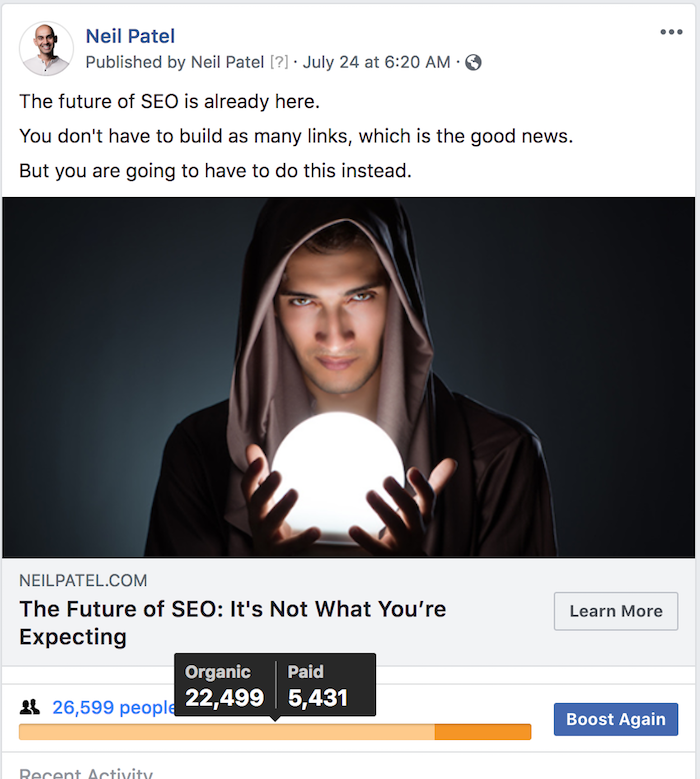
As you can see from the screenshot above, I boosted my last week’s post. I tend to boost all of my posts, which is roughly 4 times a month.
I spend $400 per post. I pick the regions: United Stated States, Canada, Australia, and the United Kingdom when boosting.
You should pick the regions where most of your ideal customers are (ideally, I should only be boosting within the United States) and make your boost lasts 2 weeks as the clicks will be cheaper than if you spent it all in one day.
If you continually do this your traffic will grow over time and you will also get more organic Facebook traffic by boosting.
If you aren’t, that means people don’t care for your content… which means you need to go back and adjust your content with the tips I broke down above.
Strategy #2: Email everyone you linked to
Within your blog post, you should have linked to other sites. As I mentioned above, you want to cite your sources and link to places where you are finding data/stats.
Every time I link to a website, I will go to their site and try to find the email of the website owner so I can let them know I linked to them.
But before I share with you an email template to send, keep in mind that you will have to modify it for your website. I can’t emphasize this enough.
And I know some of you don’t think emailing works because you get so many link building requests, but if it didn’t work you wouldn’t be getting all of those emails.
source https://neilpatel.com/blog/content-marketing-works/
No comments:
Post a Comment